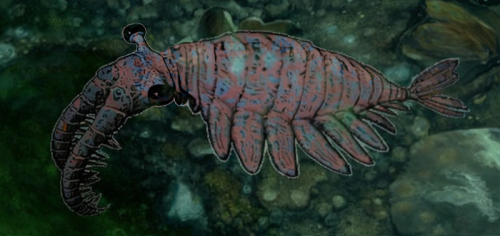BY LETTER
Anomalocaroids
 Image from Steve Bowers and Artbreeder AI |
From the earliest days of lazurogenics during the late Information Age, there has been considerable fascination among amateur gengineers with recreating the fauna of Earth's Cambrian period. The fossil record from this time shows an incredible diversity of bizarre and outlandish organisms, many of which seemed as alien to modern life on Earth as the actual aliens that would later be encountered by Terragen civilization. Among the taxa most widely known to paleontology enthusiasts during the pre-Great Expulsion period was Anomalocaris ("strange shrimp"), a genus of bizarre predatory animals believed to have been related to arthropods, which could grow to nearly half a meter in length - gigantic by the standards of contemporary species.
Although a popular subject for bioengineers, true lazurogenic reconstruction of Anomalocaris was impossible, as there was no surviving genetic material to work with, and no close extant relatives to use as a template. Paleoworld Disney developed and showcased a line of 2-meter-long "reconstructions" based on Artemiid shrimps (more commonly known as brine shrimp or "sea monkeys"), which proved to be a popular attraction despite having only a passing resemblance to the original extinct organism. The DinoPark Institute later came up with their own specimens that were even larger, based on a slipper lobster template (Scyllaridae). By the middle Interplanetary Age, these and other neo-Cambrian "lazurogens" faded into the background, as each theme park and orbital zoo habitat tried to upstage the next with newer, bigger, and more extravagant neogens that were not based on any known species, extinct or extant.
The next time "anomalocaroids" came back in vogue was during the middle Federation Period, when a number of designer genomes were posted on the InterSystemNet, which at the time reached from the Sol System to as far away as Tau Ceti and the Eridanus League. Several of these variations proved extremely popular, including such large and colorful forms as the Blue Monster, Orange Dandy and Ceres Short-Arm, which while at 4.5 meters was not the largest breed by any means was nevertheless robust, easy to care for, and could easily be interfaced with by a broad range of Federation Biodyne and GeneTEK bioware.
By the Age of Emergence, aquatic, amphibious, and even fully airborne microgravity anomalocaroids were ubiquitously found as pets, sub-sophont companions, and even guard bioborgs. The modular nature of several breeds, like the Eden Fantail, made provolution remarkably easy; however, because these were bioborgs and not "pure" organisms, the Federation Provolution Institute had no jurisdiction (other than to ensure that the 'borgs were treated humanely), and things proceeded in an unsupervised manner, with each enthusiast preferring eir own way of going about provolving eir pets. At least three different species of large space-adapted bioborg anomalocaroid provolves were recorded to have established feral populations along the frontier, and these cladized quite rapidly, developing into a host of exotic forms, including several species that developed a symbiotic relation with sapient bacteria, and the huge Cygnus Belt Leviathans, which became essentially autonomous, self-replicating and vacuum adapted bioships. Some of these have gone on to form their own minor cultures and polities; the Ghosts of the Cambrian, an enigmatic Hider civilization of space-adapted neo-Cambrian provolves, is known to contain several anomalocaroid members.
As with virtually everything else in the galaxy, anomalocaroids tend to go in and out of fashion every few centuries or so. Although subsophont, sophont, and even transapient anomalocaroids can be found widely throughout the settled worlds, with thousands of different morphotypes and variations, they are far from the most abundant of clades, although current estimates suggest some 4 trillion subsophont individuals (mostly as pets or hobby bioborgs), about eighty billion modosophonts, and several hundred transapients. They tend to be solitary creatures, although this varies according to species and morphotype. A large population can be found among the Magal World Rings.
Related Articles
- Cygnus Belt Leviathans - Text by Andrew P
Clade of enormous vacuum-adapted sophont anomalocaroid bioships found in the Cygnus Belt region whose members can reach over a kilometer in length. - DinoPark Institute (DPI) - Text by Andrew P
Early Interplanetary Age paleontological/lazurogenics research institute known for the lazurogenic reconstruction of numerous extinct taxa from Earth's prehistory. Well-known for several planetside and orbital zooeums established in SolSys during the Second and Third Centuries AT, which remained popular attractions throughout the SolSys Golden Age up until the Sundering. Frequently and mistakenly associated/confused with the much later Jurassica Institute of Paleoregeneration, which bears no relation to the DPI. - Ghosts of the Cambrian
- Lazurogen Angst
- Lazurogenics
- Neo-Cambrians - Text by Andrew P
Any of various clades derived from neogenic or spliced "lazurogens" of extinct taxa from Earth's Cambrian Era; the paraphyletic superclade known as anomalocaroids (modeled on the predatory genus Anomalocaris) are among the oldest and most widely-known Neo-Cambrians. - Paleoworld Disney - Text by Andrew P
Late Information Age - Early Interplanetary Age edutainment corporation, a subsidiary of the long-running USA-based multinational mass media conglomerate The Walt Disney Company (founded c. 46 BT). Became bitter rivals with the later DinoPark Institute during the Second Century AT, but was outcompeted and subsequently collapsed along with its parent corporation around 450 AT.
Appears in Topics
Development Notes
Text by Andrew P
Initially published on 27 September 2024.
Initially published on 27 September 2024.






